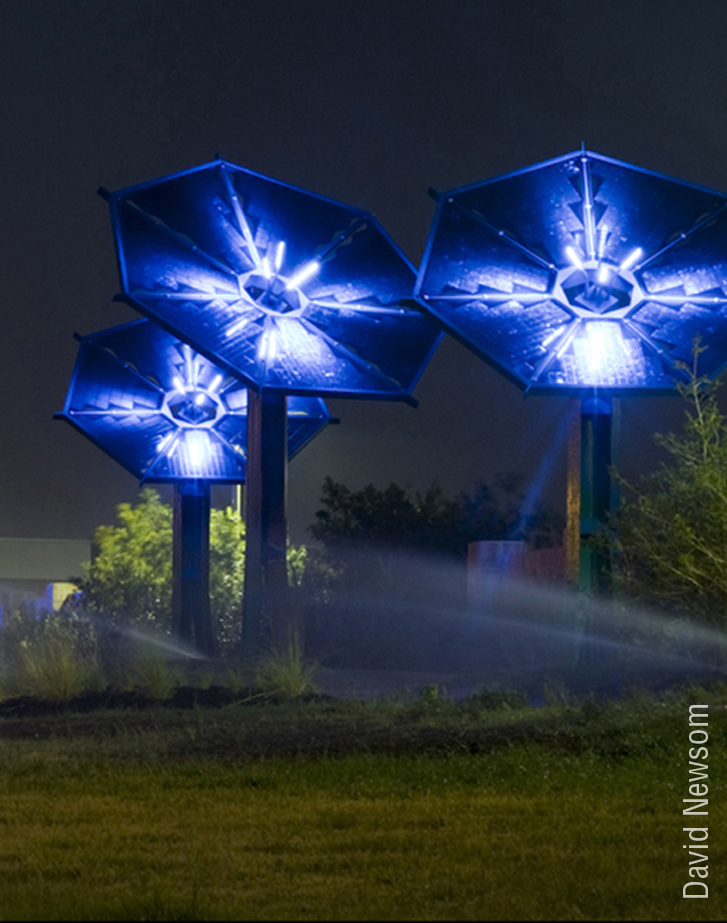“Hedfanol” (Welsh for “flight” or “flying”) is the title of a new Craft in the Bay exhibition in Cardiff, Wales. The flight-themed exhibition features contemporary original prints of birds and insects – two of only three existing animals with the power to fly. (Bats are the third.)
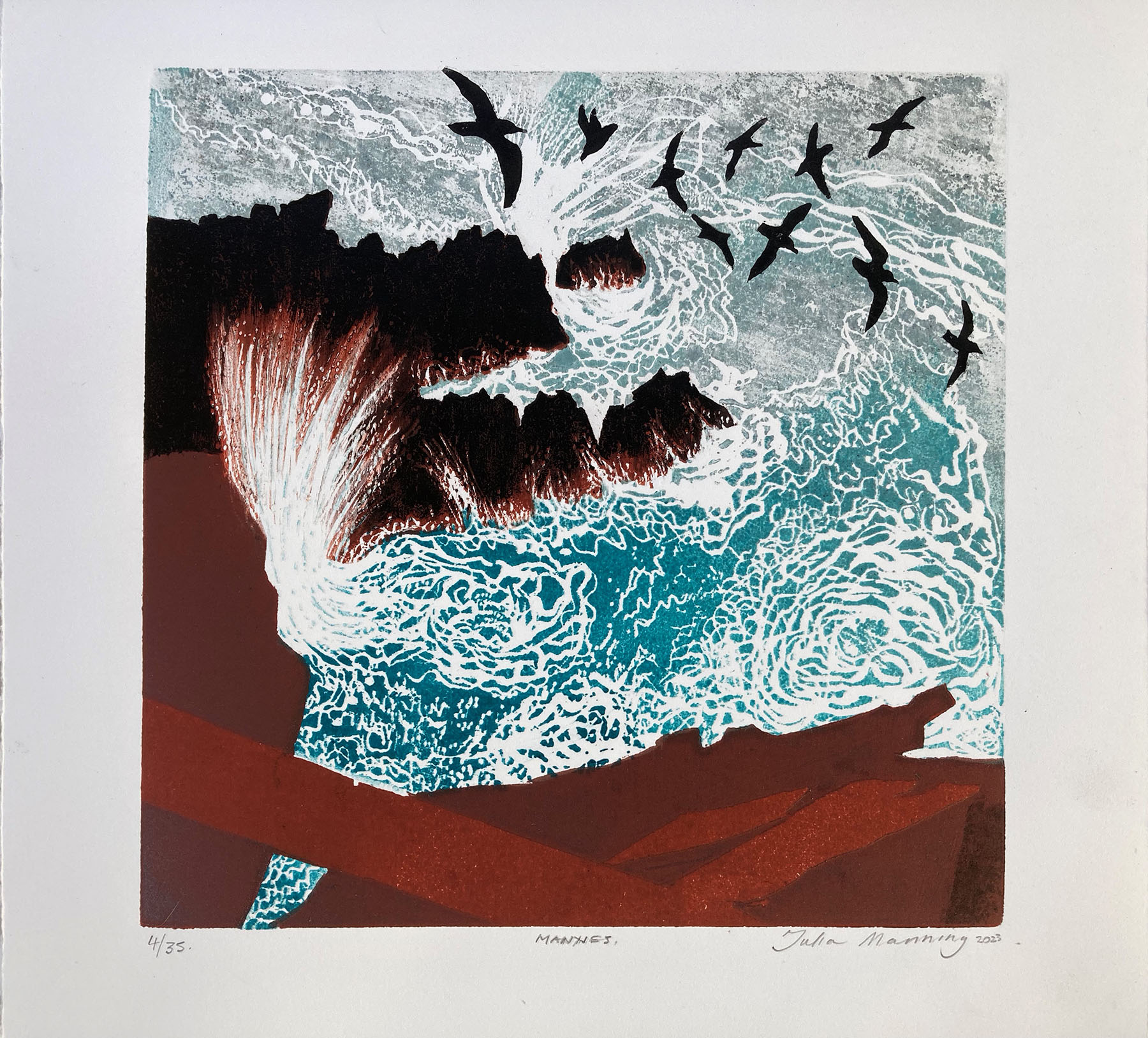
Julia Manning, Manxies. Wood and Linocuts. Image size: 30 x 30 cm. ©2023 Julia Manning. Courtesy of the Makers Guild in Wales.
Curators Marian Haf and Ruth Thomas aimed to:
- showcase “printmaking in all its glory,”
- foster “an appreciation of the natural world and in particular the wonderful world of winged creatures,” and
- draw attention to “the worrying trend of habitat loss and decline in biodiversity.”
Eight printmakers were selected for the quality of their work and the breadth of their techniques. Featured techniques include etching, drypoint, linocut, collagraph, wood engraving, woodcut, and mezzotint.
The exhibition originated with the goal of celebrating the flight of birds. The inspiration to include insect images deepened the exploration to include complex interconnections that underlie our natural world.
Birds are insect predators: they consume roughly 400 to 500 million tons of insects each year. Yet birds and insects also share complementary roles in maintaining the plant life on which they – and humans – depend.
While some bird species – e.g., hummingbirds – are pollinators, insects do the bulk of fertilization, pollinating about 80% of the world’s flowering plants and over 75% of the main crop plants that feed humans.
Pollination enables plants to produce the fruit and seeds on which birds, many insects (such as ants), and humans feed. As birds and insects feed, they may drop, expel, or discard seeds long distances from the parent plant. Seed dispersal can move plants to less crowded, less trampled, or more nutrient rich ground, facilitating a plant species’ long-term survival.
Birds and insects also share vulnerability to the same environmental threats: a warming climate, habitat destruction, and rampant pesticide use.
The 24 works on display in Hedfanol capture the stunning beauty, amazing complexity, and ecological diversity of birds and insects. Collectively, these prints make a compelling case for understanding and respecting nature’s interconnections and protecting the future of these magnificent winged creatures.
Julia Manning, creator of the Manxies print above, is passionate about translating her observations of wild, open spaces into prints. She finds inspiration near and far: “I am always surveying and examining the natural milieu around me and collecting fragments of life forms on my travels. It is a constant journey; persistently scrutinizing, learning, interpreting and then re-interpreting.”
For this print, Manning visited Skokholm Island off the coast of Wales. A tiny, largely uninhabited island in the middle of a marine sanctuary, Skokholm is a favored breeding ground of the Manx shearwaters. These medium-sized seabirds, on average about 12-15” long, boast a 30-35” wing span. They are known for their “shearing” flight: with their stiff wings extended at right angles from their body, they create the appearance of a flying cross as they tilt from side to side, almost touching the water with their wingtips. Manning’s print captures the grandeur of Manx shearwaters skimming the tops of the waves as they fly.
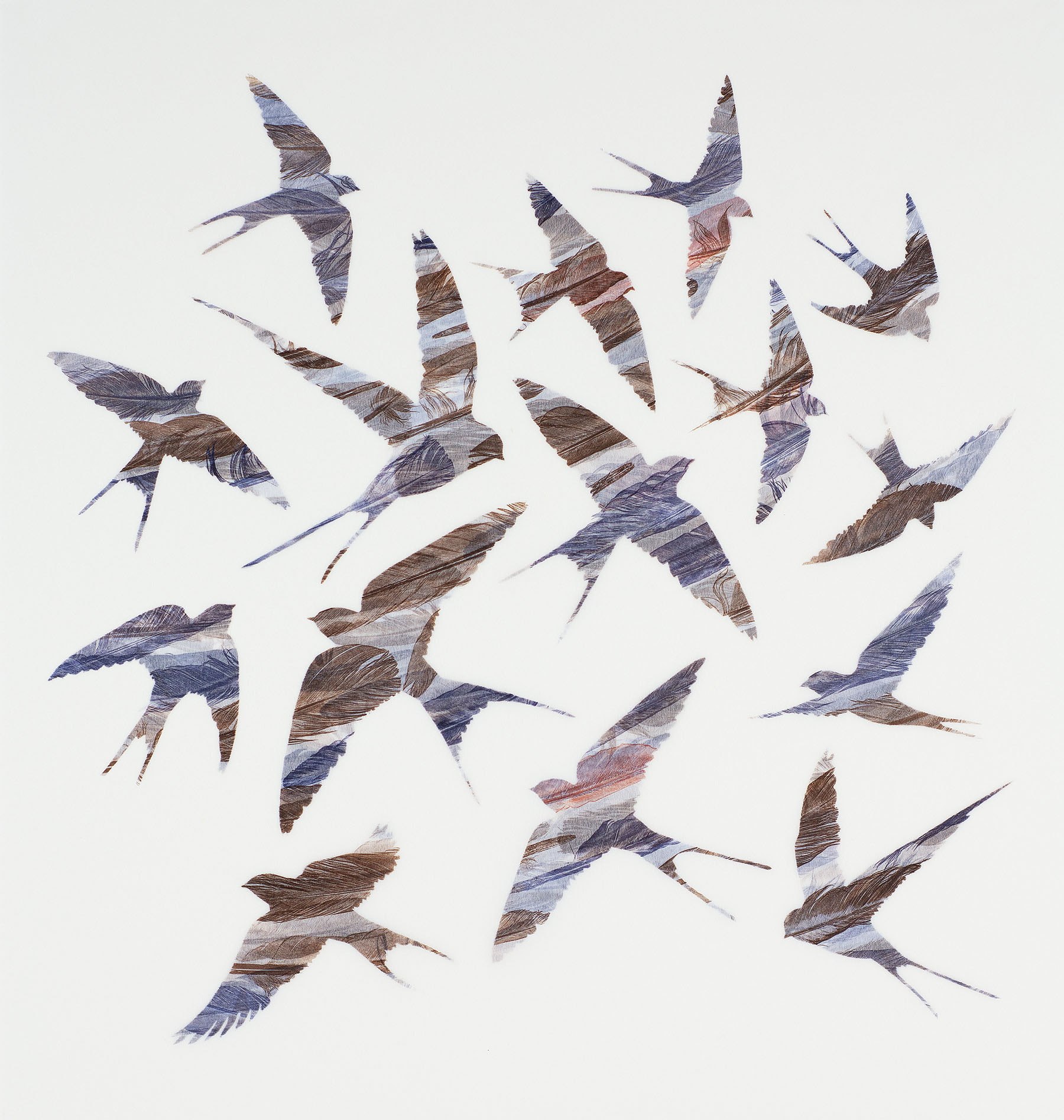
Ruth Thomas, As Swift As Swallows Fly. Original print from feathers and stencil on Japanese paper. 50 cm x 50 cm. ©2019 Ruth Thomas. Courtesy of the Makers Guild in Wales.
Living in rural Northern Wales enables Ruth Thomas to engage with, rather then merely depict, the surrounding environment. She especially enjoys collagraphy – that is, printing from a collage: “Virtually any materials can be used as long as they are fairly flat – fabrics, papers, threads, carborundum – and these days I mostly use found materials.”
On walks through her neighborhood, Thomas collects natural objects, such as feathers, and incorporates direct impressions from these objects into her prints for their textures, forms, and artistic value. Her work with feathers evolved into making prints of birds in flight – inspiration for the delicate beauty on display in As Swift As Swallows Fly.
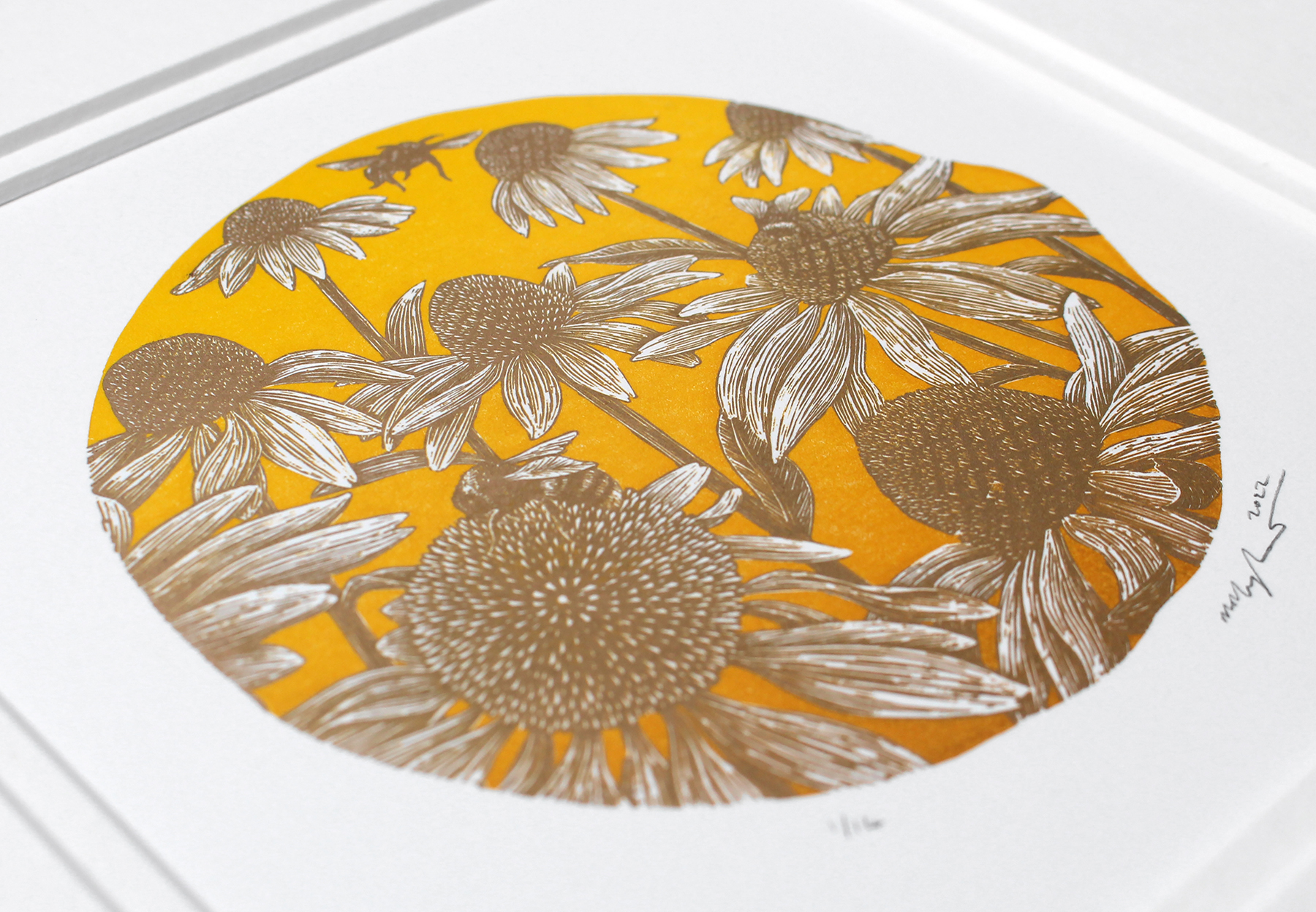
Molly Lemon, Bees and Echinacea 2022. Original boxwood engraving carved with traditional hand tools and printed by hand with a bone folder. External mount size: 27 x 27 cm. Printed area: 11.6 x 11.6 cm. ©2022 Molly Lemon. Courtesy of the Makers Guild in Wales.
Molly Lemon portrays bees in a locale they favor: buzzing atop a cluster of echinacea coneflowers. Native to the central and eastern U.S., these long-blooming perennials are easy to grow, heat and drought tolerant, and deer resistant. Importantly for pollinators, echinancea produce large, brightly colored flowers in a range visible to bees, butterflies and birds. And their nectar supply does not wane through the heat of the day, so these flowers energize as well as attract honeybees.
Lemon uses traditional hand tools to engrave her images on woodblock, then inks the block and prints on her 1868 miniature hand press. Her prints reflect the beauty and vulnerability of the natural world and, because she donates a portion of every print sold to environmental charities, they serve to advance a more sustainable future too.
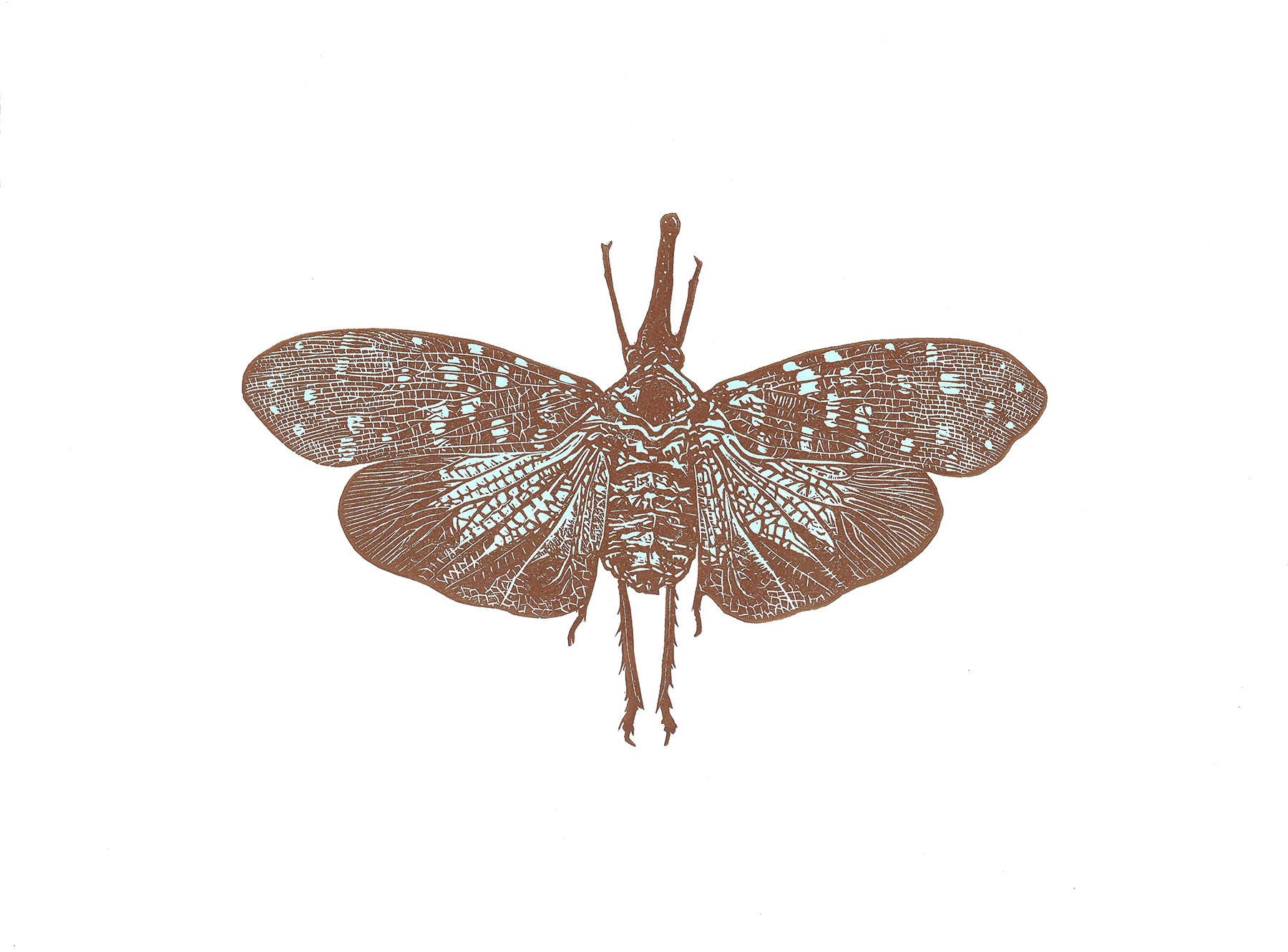
Nat McIntyre, Lanternfly. Two-colour multiple block linocut print, hand-printed in green oil-based inks on Somerset Satin paper. Paper size: 38 cm x 28 cm. Image size: 16 cm x 24 cm. ©2023 Nat McIntyre. Courtesy of the Makers Guild in Wales.
For over 25 years, Nat McIntyre has been creating art attesting to the symbolic and aesthetic value of insects. Drawing upon centuries of natural history, scientific, botanical and medical illustration, she closely examines the physical appearance of an insect to identify its minute distinctive details – its shape, color, texture. Her prints pay tribute to the wonder of insects’ intricacy and diversity. She takes care to note: “no insects were harmed in the making of this work.” (The particular specimen which inspired her Lanternfly print is on display in the insect collection of the Cambridge Zoology Museum.)
Hedfanol is on exhibit at the Craft in the Bay gallery in Cardiff until August 6, 2023. The catalogue and images are also available online.

